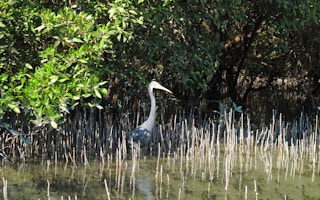Efforts should be directed towards addressing a lack of accountability in governing mangrove marine protection areas (MPA), experts said at the ongoing fifth International Marine Protected Areas Congress in Canada.
Mapping and quantifying human-driven stress factors can help achieve accountability, experts from Stanford University, NASA Goddard Space Flight Centre and East Carolina University highlighted at the congress, which aims to chart a path towards protecting 30 per cent of the ocean by 2030.
At the 15th Conference of the Parties to the Convention on Biological Diversity, 2022, countries agreed to protect 30 per cent of the planet’s lands and oceans by 2030.
Over 42 per cent of global mangrove cover is under MPA, according to the United Nations Framework Convention on Climate Change.
Mangroves cover only about 0.1 per cent of the planet’s surface. However, they can potentially store up to 10 times more carbon per hectare (ha) than terrestrial forests.
“There are hundreds of global mangrove-protected areas. Their promise is significant. But we need accountability,” Liza Goldberg, a biospheric researcher at NASA Goddard Space Flight Centre, noted.
Coastal development, climate change, logging and agriculture have put more than one in six mangrove species worldwide under extinction threat, according to the International Union for Conservation of Nature.
Further, emissions from mangrove loss could reach 2391 Teragrams of carbon dioxide equivalent by 2100, a 2021 study highlighted.
Mapping loss extent, drivers of the loss and how governance influences them are essential, she highlighted.
The experts called for an assessment of global mangrove vulnerability and real-time monitoring of marine protected areas.
“
There are hundreds of global mangrove-protected areas. Their promise is significant. But we need accountability.
Liza Goldberg, researcher, NASA Goddard Space Flight Centre
Samiya A Selim, a Professor at the University of Liberal Arts Bangladesh, said the unique and rich ecosystem of the Sunderbans mangrove forest is valuable at all scales, from local to global.
Siddharth Narayan from the Department of Coastal Studies at East Carolina University highlighted how mangroves protect coastal communities by attenuating waves during extreme events. They also reduce long-term coastal erosion by trapping sediment.
He quoted his 2009 study on a mangrove island near the upcoming Dhamra Port in Odisha. It found that salt-tolerant trees effectively reduced wave heights.
“While the mangrove island’s protective effect is limited by its distance from the coast, it still causes a nearly 60 per cent reduction in wave heights at the coast,” the study read.
Narayan’s yet-to-be-released analysis found that mangroves are most beneficial against smaller but more frequent weather events.
Stef Simpson, Coastal Climate Program Manager, The Nature Conservancy (Global), spoke about using carbon markets to finance mangrove conservation in MPAs.
As these salt-tolerant trees store carbon in their soil and sediments, it stays locked for thousands of years if left undisturbed.
Carbon markets allow carbon credits to be sold and bought. One carbon credit equals one tonne of carbon dioxide or the equivalent amount of a different greenhouse gas reduced, sequestered or avoided.
This story was originally published on Down to Earth.










